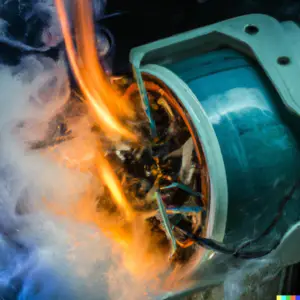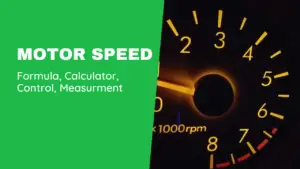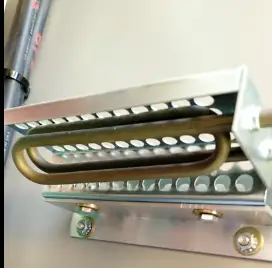Electric motors are a critical component of many industrial and commercial applications, providing power to drive everything from pumps and compressors to conveyors and manufacturing equipment.
However, when motors are subjected to overcurrent – a condition where the current flowing through the motor exceeds its rated capacity – they can experience a range of negative symptoms.
These symptoms can include reduced performance, excessive heat, noise and vibration, stalling or tripping, damage to motor components, and increased energy consumption.
In this article, we will explore each of these symptoms in detail, as well as the causes of overcurrent and strategies to prevent it.
Understanding the risks and taking proactive measures to address overcurrent can help ensure that motors operate safely, efficiently, and reliably over the long term.
Table of Contents
1. Motor stalling or tripping:
When a motor is overloaded, it may not be able to handle the current flowing through it. This can cause the motor to stall or trip the overload protection device.
The overload protection device is designed to protect the motor from damage by shutting off power to the motor before it can be damaged.
When a motor stalls, it stops rotating and may make a humming or buzzing noise. If the motor is equipped with a thermal overload protection device, it may take some time for the motor to cool down and reset the protection device before it can be restarted.
If the motor is equipped with an electronic overload protection device, it may need to be reset manually.
If the overload protection device is tripping frequently, it could be a sign of a problem with the motor or the system. Some possible causes of frequent tripping include:
- Overloading due to an excessive load or an incorrect load calculation.
- Short circuit in the system.
- Faulty overload protection device.
- Damaged motor windings or insulation.
It is important to identify and address the root cause of the overcurrent condition to prevent further damage to the motor or the system.
2. Excessive heat:

When a motor is overloaded, the current flowing through it generates heat. If the motor is unable to dissipate the heat effectively, it can cause the motor to overheat. Overheating can cause damage to the motor windings, insulation, or bearings.
The motor windings are insulated with a material that can withstand a certain amount of heat. If the windings are subjected to excessive heat, the insulation can break down and cause a short circuit. This can lead to a complete failure of the motor or even a fire.
The bearings in a motor can also be damaged due to excessive heat. When the bearings are subjected to high temperatures, they can lose their lubrication properties, leading to premature failure of bearings.
This can cause the motor to become noisy and can also affect the performance of the system.
To prevent overheating, it is important to ensure that the motor is operated within its rated current and temperature limits.
Proper ventilation and cooling should also be provided to the motor, especially in high-temperature environments.
Read also my comprehensive article: Motor Temperature Rise (Causes and Limits).
3. Reduced performance:
When a motor is overloaded, it may not be able to operate at its full capacity. This can result in reduced speed or torque, which can affect the performance of the system.
The reduced performance can be caused by the motor struggling to maintain its normal operation under the increased load.
For example, in a conveyor system, if the motor is not able to provide the required torque, the conveyor may not be able to move the materials at the required speed.
Similarly, in a pump system, if the motor is not able to deliver the required flow rate, the pump may not be able to maintain the desired pressure.
To avoid reduced performance due to overcurrent, it is important to ensure that the motor is properly sized and selected for the application.
Proper load calculations should be performed to determine the maximum load that the motor can handle.
4. Noise or vibration:
When a motor is overloaded, it may produce noise or vibration. The noise or vibration can be caused by the motor struggling to maintain its normal operation under the increased load.
If the noise or vibration is severe, it can be a sign that the motor is in danger of stalling or overheating.
The noise or vibration can be caused by a variety of factors, such as:
- Bearing failure due to overheating or excessive load.
- Misalignment of the motor or the driven equipment.
- Mechanical damage to the motor or the driven equipment.
- Electrical problems, such as unbalanced voltage or frequency.
To address noise or vibration due to overcurrent, it is important to first identify the root cause.
This may involve inspecting the motor and the driven equipment, checking for proper alignment and balance, and ensuring that the electrical system is functioning properly.
5. Damage to motor components:
Overcurrent can cause damage to various components of the motor, including the windings, insulation, bearings, and shaft.
The damage can be caused by the excessive heat generated by the overcurrent, as well as the mechanical stresses placed on the components.
For example, the windings of a motor can be damaged due to overheating, causing insulation breakdown and short circuits.
The bearings can also be damaged due to excessive heat or mechanical stresses, leading to premature failure.
To prevent damage to motor components due to overcurrent, it is important to ensure that the motor is operated within its rated current and temperature limits.
Proper maintenance and inspections should also be performed to detect any signs of damage or wear on the motor components.
6. Increased energy consumption:
When a motor is overloaded, it requires more energy to operate. This can result in increased energy consumption and higher energy bills.
The increased energy consumption can also put a strain on the electrical system, potentially causing other problems such as voltage drops or overheating.
To reduce energy consumption due to overcurrent, it is important to ensure that the motor is properly sized and selected for the application.
Proper load calculations should be performed to determine the maximum load that the motor can handle and energy-efficient motors should be used whenever possible.
In addition, regular maintenance and inspections should be performed to ensure that the motor is operating at peak efficiency and that any energy-saving opportunities are identified and implemented.
Conclusion
In summary, motor overcurrent can cause a range of symptoms, including stalling or tripping, excessive heat, reduced performance, noise or vibration, damage to motor components, and increased energy consumption.
It is important to identify and address the root cause of overcurrent to prevent further damage to the motor or the system.
Proper maintenance and inspections, as well as proper selection and sizing of the motor, can help prevent overcurrent and its associated symptoms.
Don’t Leave Empty-Handed!
Install my Free Android App on Google Play:
Electrical Cables Most Common Tables “Cables Tables”
And, my Electrical Calculations App “Fast Electrical Calculator”
Discover more great content by subscribing to My channel
Looking to stay ahead of the game in the world of electrical engineering? Subscribe to my YouTube channel and gain access to exclusive content you won’t find anywhere else!
The staff I recommend
(Amazon Affiliate Links to products I believe are high quality):
- Economy 120 Volt/60Hz AC Power Source – Step-Down Voltage & Frequency Converters 1800W
- UNI-T Digital Multimeter Tester UT139C
- 50-Amp Extension Cord for RV “100ft”
- Voltage Stabilizer 110/220v
- Hair Dryer “best selling“
- TOSHIBA EM131A5C-BS Countertop Microwave Ovens
Disclaimer: This contains affiliate links to Amazon products. I may earn a commission for purchases made through these links.


